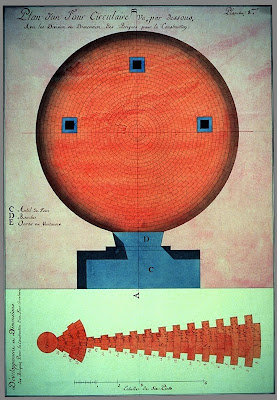
Bakery oven by Dromard (~1794) showing vent holes
{I think it's a view inside the oven looking up}. The lower
section is a schematic of brick placement.
{I think it's a view inside the oven looking up}. The lower
section is a schematic of brick placement.
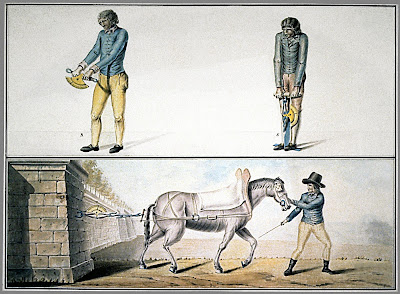
French rifle maker and inventor Edme Régnier constructed
a dynamometer in about 1790 which was able to measure both
tension and pressure exerted by a person or animal. An
anthropological expedition in 1800 to the South Seas employed
this device to gauge whether there was a relationship between
physical degeneration and civilization progress. In his
conclusion, "Péron claims that one must assume that the
state of savageness is actually a state of feebleness". (ref)
a dynamometer in about 1790 which was able to measure both
tension and pressure exerted by a person or animal. An
anthropological expedition in 1800 to the South Seas employed
this device to gauge whether there was a relationship between
physical degeneration and civilization progress. In his
conclusion, "Péron claims that one must assume that the
state of savageness is actually a state of feebleness". (ref)
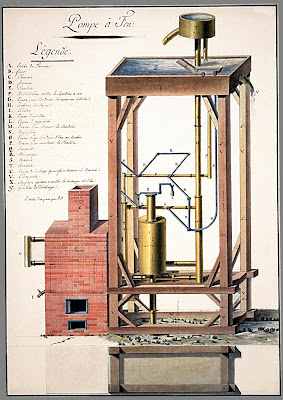
Steam driven fire hose pump designed by Jacques Gadon in ~1798.
It was installed in the grounds of the French Academy of Science in 1799.
It was installed in the grounds of the French Academy of Science in 1799.
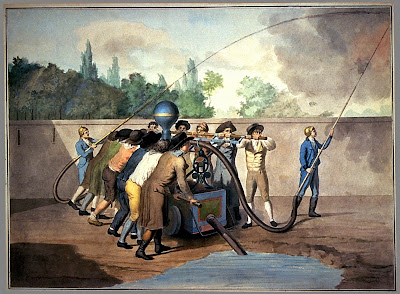
Joseph Bramah from Yorkshire held 3 important patents for hydraulic pumps
that would receive wider applications as replacements for screw pumps. The
picture from the last decade of the 18th century shows of course a fire hose
pump in action. Somehow this pump came to be acquired by the French Academy
of Science as one of its first purchases for which they had to pay restitution some
years later (something about it being seized during the latter days of the revolution).
that would receive wider applications as replacements for screw pumps. The
picture from the last decade of the 18th century shows of course a fire hose
pump in action. Somehow this pump came to be acquired by the French Academy
of Science as one of its first purchases for which they had to pay restitution some
years later (something about it being seized during the latter days of the revolution).

Pulley systems sketched by Dromard in ~1800 on a
commission from the French Academy of Science.
commission from the French Academy of Science.
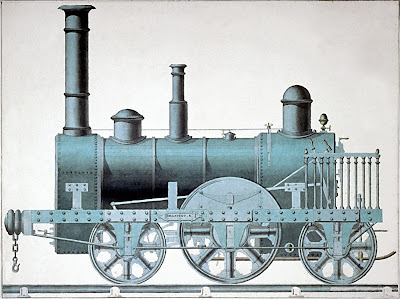
Sketch by Billaudet from the end of the 19th century (or is it 18th??).

As best I understand it, this is a part-cutaway view from above of an
hydraulic sheet metal cutter for boiler making - a design by the Swiss
industrialist Johann-Sebastian Von Claiss, who worked closely with the
French government at the end of the 18th century.
hydraulic sheet metal cutter for boiler making - a design by the Swiss
industrialist Johann-Sebastian Von Claiss, who worked closely with the
French government at the end of the 18th century.
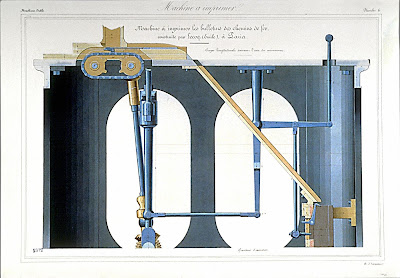
Printing machine for the railway bulletin designed
by Émile Lecoq (drawing by Lavasseur, 1855).
by Émile Lecoq (drawing by Lavasseur, 1855).
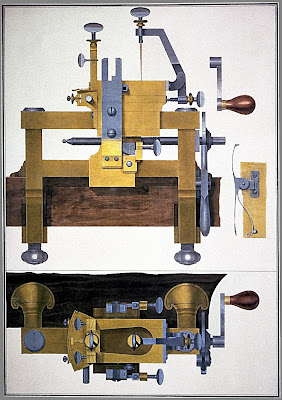
The French Academy of Science through their Bureau of Arts and Trades sought
to identify and encourage notable inventors at the end of 18th century. On the
recommendation of Lavoisier, Jean-Godefroy Mercklein received a monetary
award for his leather marking/punch machine (among his other inventions).
to identify and encourage notable inventors at the end of 18th century. On the
recommendation of Lavoisier, Jean-Godefroy Mercklein received a monetary
award for his leather marking/punch machine (among his other inventions).
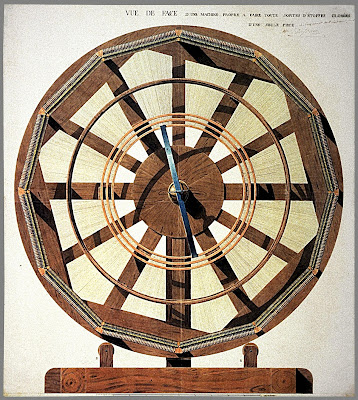
I don't really understand this. This sketch relates to a patent that
was granted to Nicolas-Marie Dufour in 1808 for a wig making design.
Somehow this curious device was supposed to seamlessly weave
hair and silk, driven by a complex of pulleys. O...K.
was granted to Nicolas-Marie Dufour in 1808 for a wig making design.
Somehow this curious device was supposed to seamlessly weave
hair and silk, driven by a complex of pulleys. O...K.
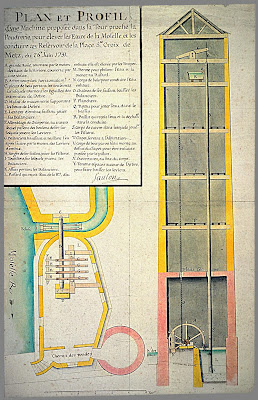
A 1731 plan by a draughtsman named Saulon for the construction
of a water drawing tower on the Moselle River in Metz.
of a water drawing tower on the Moselle River in Metz.
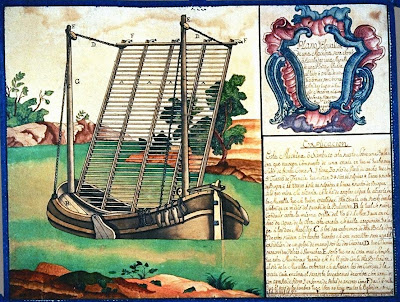
This watercolour design of a ship-mounted attack ladder from
1755 was made in Barcelona and is said (website commentary)
to show the poor quality of technical illustration in the 18th century.
1755 was made in Barcelona and is said (website commentary)
to show the poor quality of technical illustration in the 18th century.

Sketch from about 1800, in the style of Diderot's L'Encyclopédie,
showing the manufacting of sewing needles.
showing the manufacting of sewing needles.
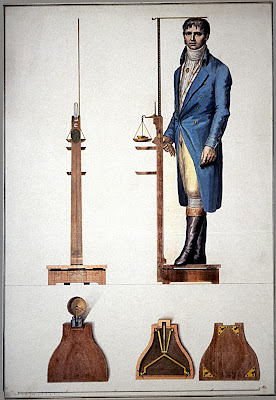
Held by the French Academy of Science, this sketch depicts
a lever-controlled, portable scale from ~1805 - a variation
of a contemporary design by Thomas Kettle from England.
a lever-controlled, portable scale from ~1805 - a variation
of a contemporary design by Thomas Kettle from England.
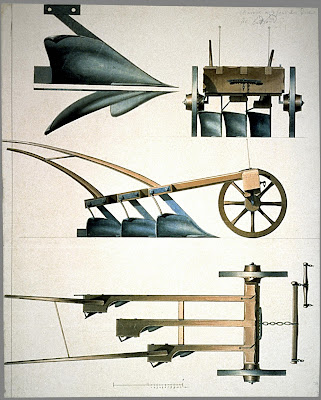
Various views of 3-pronged ploughshares from an
1807 design for the French Agricultural Society.
1807 design for the French Agricultural Society.

There are no accompanying notes to this sketch other than
indicating that is'Cinématorama, spoken about by Auguste Baron'
"Auguste Baron's Speaking Cinématorama".
Baron was a civil engineer and one of the early pioneers in sound films.
indicating that is
"Auguste Baron's Speaking Cinématorama".
Baron was a civil engineer and one of the early pioneers in sound films.

This early 19th century sketch is not, as I at first guessed, a stylized depiction
of a post-revolutionary French terrorist, but rather, it's quite the opposite: the
model is wearing the latest in shipwreck personal flotation devices. It seems
there was a flurry of industrious activity applied to rescue belts and harnesses
in the late 18th century, spurred on by design contests in (at least) France,
England and Sweden. They all relied (of course) on leather air bladders and/or
cork filled compartments and I think the above picture was one of many
submitted to the French Academy of Science for approval and/or award.
of a post-revolutionary French terrorist, but rather, it's quite the opposite: the
model is wearing the latest in shipwreck personal flotation devices. It seems
there was a flurry of industrious activity applied to rescue belts and harnesses
in the late 18th century, spurred on by design contests in (at least) France,
England and Sweden. They all relied (of course) on leather air bladders and/or
cork filled compartments and I think the above picture was one of many
submitted to the French Academy of Science for approval and/or award.
Le Portefeuille Industriel is a collection of technical drawings from Musée des Arts et Métiers. The web display favours the more artistic examples from the collection prior to ~1815 after which the drawing style became more austere. The website provides in many cases quite a bit of background (all in french) and I've posted the majority of the collection [click on the images above for much larger versions - thanks to viewing the page source]. All care taken with translation/interpretation but I would never rely on me - mouseover the images for the original website captions in french.
No comments:
Post a Comment